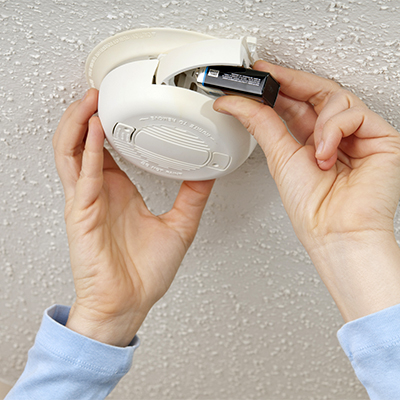Smoke alarm essentials that could save lives
- Research shows there are 52 fire-related deaths in Australian homes on average per year1
- The risk of a fatality in a home fire is halved with a working smoke alarm installed2
- To protect your home and family, find out which smoke alarms fire authorities recommend and follow our simple tips to keep them working effectively.
Hands up if you’re 100% sure your smoke alarms are working, and meet your state government’s requirements.
For many Australians, smoke alarms are ‘set and forget’, and only come to mind when they beep for a battery change or when a stir-fry sets them off.
Working fire alarms are your best defence against home fires, especially with 43% of fire-related deaths occurring while resting or sleeping1 when your sense of smell is reduced.
Just a few minutes is all it takes to maintain smoke alarms, which could save lives and minimise property damage.
Types of smoke alarms and where to place them
While laws vary (see below for what’s required in your state), all Australian homes must have a working smoke alarm. The three recommended types of alarms are photoelectric, ionisation or long-life lithium battery powered.
Photoelectric
The gold standard is photoelectric mains-powered smoke alarms that are interconnected, so when one alarm activates they all sound. Photoelectric alarms are more sensitive which helps detect fire earlier, even at the smouldering stage. You’ll need a licensed electrician to install any hard-wired smoke alarm.
Long-life lithium
The next best option is long-life lithium powered smoke alarms with a 10-year battery (which means no constant beeping to replace flat batteries).
Ionisation
Ionisation smoke alarms ‘smell’ smoke so shouldn’t be placed near kitchens or fireplace areas. They can be installed in homes right across Australia, except the Northern Territory3.
So where do you install them? Rules vary by state, but the common recommendation is to install smoke alarms on each storey, in each bedroom and in hallways that connect bedrooms4. The general rule is to mount the alarms in the centre of the ceiling.
Tips to maintain your smoke alarms
Every month: check they’re working by pressing the test button until the alarm sounds.
Every six months: vacuum your smoke alarms to maximise performance.
Every 10 years: replace all smoke alarms (more often if the manufacturer recommends).
If you’re using ionisation smoke alarms, replace the battery if you hear it beeping. Fire and Emergency Services Queensland suggests bookmarking batteries to be changed every April 15.
Understanding the law is essential for homeowners, landlords and renters
- Homeowners: know what’s required to protect loved ones and your major asset
- Landlords: it’s your responsibility to install and maintain smoke alarms to protect your property and tenants
- Renters: know your rights and the obligation to report smoke alarms that don’t work
- When checking your fire alarms are in order, it is always important to check if your home, contents or landlord insurance covers your assets for fire.

Australian smoke alarms – rules in your state
NSW
It’s the law to have at least one smoke alarm installed on every level of your home, even levels with no bedrooms (this means any building where people sleep, including relocatable homes, caravans and campervans). Find out more.
Victoria
Smoke alarms are compulsory for every residential building and must be installed on or near the ceiling of every storey (including between each bedroom area and the rest of the dwelling). Find out more.
Queensland
The law is changing: owner-occupiers of all private homes, townhouses and units must install interconnected smoke alarms by 2027. They must be hardwired photoelectric or non-removable lithium battery-powered, installed on all storeys, in each bedroom, and in hallways that connect bedrooms. Find out more.
Western Australia
The law requires mains-powered smoke alarms for homes built or significantly renovated after July 1997, or sold or rented after October 2009. For all other dwellings, mains-powered photoelectric smoke alarms are recommended, and long-life lithium powered alarms are the next best option. Find out more.
South Australia
Homes built since 1995 require hardwired smoke alarms, and from 2014 they must be interconnected. All other houses must have at least replaceable battery-powered smoke alarms. Find out more.
Tasmania
You should install smoke alarms in all sleeping areas, hallways, living areas and tops of stairways. All new residential buildings and major renovations require mains-powered or lithium battery smoke alarms. Find out more.
Northern Territory
Photoelectric smoke alarms, either hardwired or sealed lithium battery units, must be installed in all residential premises (including movable dwellings like caravans). Homeowners with non-approved smoke alarms don’t have to replace them until they stop working. Find out more.
ACT
Working smoke alarms are compulsory, and interconnected photoelectric smoke alarms are preferred. They should be installed on or near the ceiling in bedrooms or in corridors leading to bedrooms, and must be installed on each level of the home. Find out more.
No matter which state you live in, the message from fire authorities is clear – smoke alarms can only save lives if they’re working.
Install and maintain smoke alarms to protect your loved ones, and develop a home fire escape plan that everyone understands.
1 https://nla.gov.au/nla.obj-3107681199/view?showSensitive=y
2 https://www.fire.nsw.gov.au/page.php?id=80
3 https://www.aph.gov.au/Parliamentary_Business/Committees/Senate/Legal_and_Constitutional_Affairs/Fire_safety/Report/c03
4 https://www.cfa.vic.gov.au/plan-prepare/fires-in-the-home/smoke-alarms/installation-and-maintenance
5 https://statements.qld.gov.au/statements/86983
